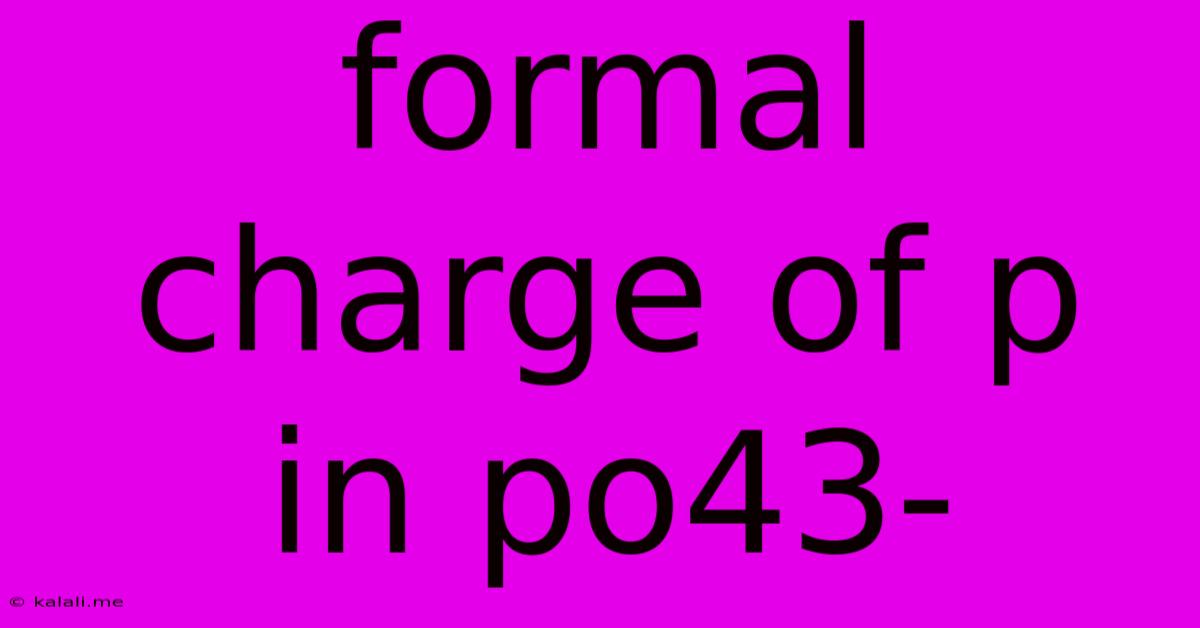Formal Charge Of P In Po43-
Kalali
Jun 16, 2025 · 3 min read

Table of Contents
Calculating the Formal Charge of Phosphorus in PO₄³⁻
Understanding the formal charge of atoms within a molecule or ion is crucial for predicting its reactivity and stability. This article will guide you through the step-by-step calculation of the formal charge of phosphorus (P) in the phosphate ion (PO₄³⁻), a common polyatomic anion found in many biological and chemical systems. Learning this process will improve your understanding of chemical bonding and structure.
What is Formal Charge?
Formal charge is a theoretical charge assigned to an atom in a molecule, assuming that electrons in all chemical bonds are shared equally between the atoms. It helps determine the most likely Lewis structure for a molecule by identifying the structure with the lowest formal charges on each atom. It's important to remember that formal charge is not the same as the actual charge on an atom.
Steps to Calculate Formal Charge:
To calculate the formal charge of phosphorus in PO₄³⁻, follow these steps:
-
Determine the Valence Electrons: Phosphorus (P) is in Group 15 of the periodic table, so it has 5 valence electrons. Oxygen (O) is in Group 16, giving it 6 valence electrons each.
-
Count the Non-bonding Electrons: In the most stable Lewis structure of PO₄³⁻, phosphorus is singly bonded to each of the four oxygen atoms. Phosphorus has zero non-bonding electrons (lone pairs).
-
Count the Bonding Electrons: Each bond consists of two electrons. Since phosphorus forms four single bonds, it has 4 x 2 = 8 bonding electrons.
-
Calculate the Formal Charge: The formula for formal charge is:
Formal Charge = (Valence Electrons) - (Non-bonding Electrons) - (1/2 x Bonding Electrons)
For phosphorus in PO₄³⁻:
Formal Charge (P) = 5 - 0 - (1/2 x 8) = 5 - 0 - 4 = +1
Therefore, the formal charge of phosphorus in the phosphate ion (PO₄³⁻) is +1.
Understanding the Result:
The +1 formal charge on phosphorus in PO₄³⁻ indicates that, according to this model, phosphorus has one less electron than it would in a neutral state. This is consistent with the overall -3 charge of the phosphate ion, as the four oxygen atoms contribute a total of -8 formal charge (each oxygen atom has a -1 formal charge), and the phosphorus atom contributes a +1 formal charge. The overall sum is -7, compensated by the overall -3 ion charge and +4, hence the charge of -3. This is a common example of resonance structures where this can vary depending on the assigned structure.
Resonance Structures and Formal Charge:
It's important to note that the phosphate ion exhibits resonance, meaning that the actual structure is a hybrid of several contributing Lewis structures. While the formal charge calculation above shows a +1 formal charge for phosphorus in one contributing structure, the average formal charge across all resonance structures is closer to zero. However, understanding the formal charge in individual structures is still helpful in understanding the bonding and behavior of the ion.
Conclusion:
By following the steps outlined above, we've successfully calculated the formal charge of phosphorus in the phosphate ion. Understanding formal charge is a valuable skill for anyone studying chemistry, helping to predict molecular properties and stability. Remember to consider resonance structures for a complete picture of the molecule's electronic distribution.
Latest Posts
Latest Posts
-
Principle Of Operation Of Centrifugal Pump
Jun 16, 2025
-
Is Anything That Has Mass And Occupies Space
Jun 16, 2025
-
Which Of These Is Not Part Of The Decision Making Process
Jun 16, 2025
-
Which Historical Events Are In The Correct Chronological Order
Jun 16, 2025
-
Which Of The Following Is A Probability Sampling Method
Jun 16, 2025
Related Post
Thank you for visiting our website which covers about Formal Charge Of P In Po43- . We hope the information provided has been useful to you. Feel free to contact us if you have any questions or need further assistance. See you next time and don't miss to bookmark.